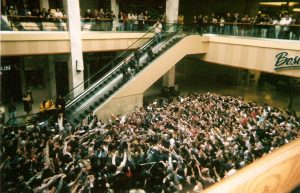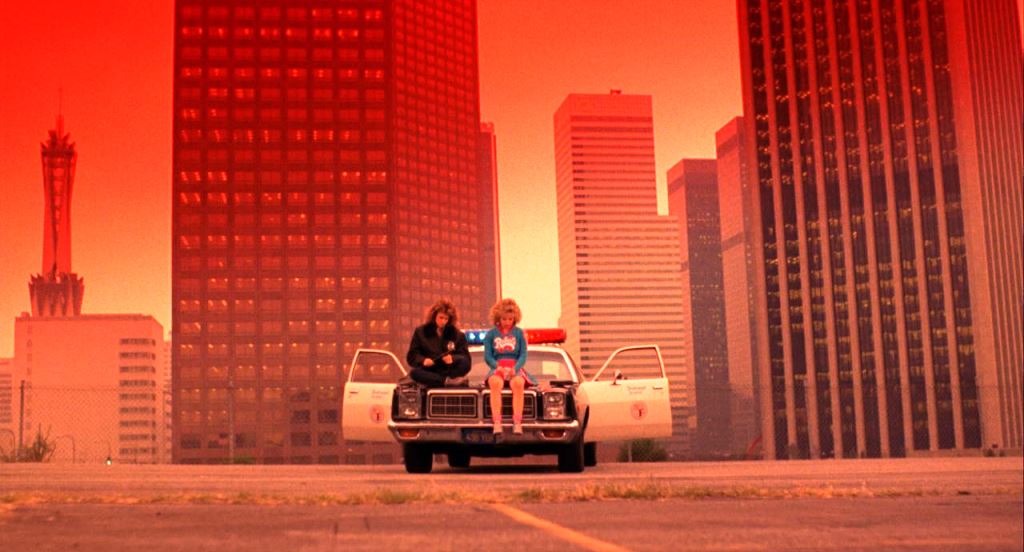
Some of my favorites movies were set in malls. Fast Times At Ridgemont High, Scenes From A Mall, Mallrats and of course George Romero’s 1978 classic Dawn Of The Dead. On screen and off Malls function as a temple of both consumerism and capitalism . Mall are places where shopping is an experience combining dining, consuming and resting in one convenient location. The American mall is the biggest expression of physical capitalism. and generally drawing out the shopping process as much as possible.
It is also where 80 percent of all multiplexes are located…and there is a problem, Malls are dying.
With the rise of online shopping and the hit that retail stores took during the “great recession,” brick and mortar shopping centers saw major declines in sales. Between March 2008 and April 2009, mall tenants in the United States posted an overall loss of 6.5 percent. That same year, Standard and Poor’s lowered the credit rating of the department store sector.
Green Street Advisors, a real estate advisory group, predicted in 2014 that 15 percent of malls in the U.S. would be closed and/or converted into non-retail property over the course of the next 10 years. It’s not predicted that malls will ever bounce-back to their pre-recession earnings. They have recently increased that number to 30%. Most prognosticators concur that this number will climb.
Malls were designed to basically replace the Main Streets of many communities across America. To mimic what had evolved in downtown cores of most centers and compete. The problem is that that they competed and competed so well that they ended up destroying many a downtown economy, including the local movie theatre. Before World War II, Main Street was the community’s primary commercial hub. Downtown buildings usually had several tenants most likely a ground-floor retailer and, as well several upper-floor offices or apartments; together, these tenants provided enough rent for property owners to keep their buildings in good condition. With the positioning of the local post office, library, banks and local government offices contributed to the flow of consumers downtown. Main Street was the center of a town commercial and social life. On weekends life; people thronged the streets on any Saturday nights to meet friends, see a movie and window-shop.
For the past 40 years, America’s downtown’s have been decimated by the rise of the mall economy. The building of the the interstate highway system and the sudden rise of suburban communities, changed the ways in which Americans live, work and play .People found it easier to travel longer distances to work or shop. Roads that once connected neighborhoods to downtown now carried residents to giant regional malls. Throughout the nation, in town after town, city after city, the story was the same. Downtown businesses closed or moved to the mall, consumers went away, property values and sales tax revenues sank. People forgot how important their downtown and its historic commercial buildings were in reflecting their community’s unique heritage. Single and double screen theatres closed by the thousands and re-invented themselves within a mall economy.
The Mall flourished….until.
In 1994, Jeffrey Bezos left his job as vice-president of the Wall Street brokerage firm D.E. Shaw, moved to Seattle, and began to work out diligently a business plan for what would become Amazon.com. After reading a report that projected annual Web growth at 2,300 percent, Bezos made a a list of 20 products that could be sold on the Internet. He narrowed the list to what he felt were the five most promising: compact discs, computer hardware, computer software, videos, and books. Bezos made the call that this venture would sell books over the Web, due to the large worldwide market for literature, the low price that could be offered for books, and the tremendous selection of titles that were available in print. He chose Seattle as the company headquarter. In July 1995 Amazon.com had its debut and quickly became the number one book-related site on the Web.
Unlike its large competitors, such as Barnes & Noble and Borders, Amazon.com carried only about 2,000 titles in stock in its Seattle warehouse. Most orders through Amazon.com were placed directly through wholesalers and publishers, so no warehouse was needed. Amazon.com would simply receive the books from the other sources, then ship them to the customer. In the year 2003 Amazon.com acquired the online music retailer CD Now. This year also forced changes to their product line up as well with the introduction of gourmet food, outdoor sports equipment and health and personal care items. An important development for this e-commerce giant was the introduction of Amazon Prime which provides students with unlimited free express shipping at a rate of $79 a year.
Over the 2000-2010 decade, Amazon has developed a customer base of around 30 million people. Amazon.com is primarily a retail site with a sales revenue model. Amazon makes its money by taking a small percentage of the sale price of each item that is sold through its website. Amazon also allows companies to advertise their products by paying to be listed as featured products.
For Malls here is the simple fact that will spell its doom. The number of consumers browsing and buying online will hit 270 million by 2020, driven largely by activity on mobile devices. Online sales in the United States are expected to reach $523 billion in the next five years, up 56% from $335 billion in 2015. This is course these are sales which would have been previously been made at Malls. The Malls are against the ropes and it is not looking good, Amazon and Ebay are not going away anytime soon.
Now that the Mall is on life support, a new trend is rising driven by the fact that the American population, contrary to many held opinion, is not too interested in being mobile, it turns out the new and rising college-educated professionals between the ages of 25 and 34, tends to want to for themselves. They want a place in tight-knit urban neighborhoods that are close to work and have lots of entertainment and shopping options within an easy walk. In the first decade this grew the population base in the downtown core by 23% . The cities and towns that capture the mobile, college-educated young are the ones who are most likely to revitalize their downtown’s and accelerate economic progress in their cities and towns.
It is also the demographic that movie theatres desperately need in order to maintain a revenue base.
Eyes are being turned once again to the neglected downtown cores, the natural and proper home for a community based movie theatres. With the development of various re-vitalization zones, art district and redevelopment support from groups like Main Street USA, maybe it time for theatres to look once again and locating in the core of a town and or a city.
Maybe its time for maybe a good old threeplex located in a downtown core…..sigh……but one thing is for sure, Malls have had their day.

